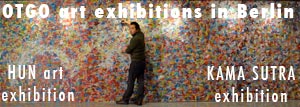 'ZURAG' film original in German 2010 Berlin
'ZURAG' film original in German 2010 Berlin'ZURAG' film in the Mongolian national television, 2011 Ulan Bator
(Original record from the MNB broadcast)
 'ZURAG' film original in German 2010 Berlin
'ZURAG' film original in German 2010 Berlin| Deutsch
- Zweites
Kapitel: Tschingis
Chaans Jugend English - Second Chapter: Genghis Khan's Youth info: Karakorum Karakorum (Khalkha Mongolian: Хар Хорум "Kharkhorin", Classical Mongolian: Qara Qorum) was the capital of the Mongol Empire in the 13th century, although for only about 30 years. Its ruins lie in the northwestern corner of the Övörkhangai Province of Mongolia, near today's town of Kharkhorin, and adjacent to the Erdene Zuu monastery. They are part of the upper part of the World Heritage Site Orkhon Valley Cultural Landscape. History: Foundation The Orkhon valley had already been a center of the Xiongnu, Göktürk and Uighur empires. To the Göktürks, the nearby Khangai Mountains had been the location of the Ötüken, and the Uighur capital Karabalgasun was located close to where later Karakorum would be erected. This area is probably also one of the oldest farming areas in Mongolia. In 1218/19, Genghis Khan rallied his troops for the campaign against the Khwarezm Empire in a place called Karakorum, but the actual foundation of a city is usually said to have only occurred in 1220. Until 1235, Karakorum seems to have been little more than a yurt town, only then, after the defeat of the Jin empire did Genghis' successor Ögedei erect walls around the place and build a fixed palace. Prosperity Under Ögedei and his successors, Karakorum became a major site for world politics. Möngke Khan had the palace enlarged, and the great stupa temple completed. William of Rubruck William of Rubruck, a Flemish Franciscan missionary and papal envoy to the Mongols reached Karakorum in 1254. He has left one of the most detailed, though not always flattering, accounts of the city. He compared it rather unfavourably to the village of Saint-Denis near Paris, and stated that the monastery in said village is ten times as important as the Khan's palace. On the other hand, he also described the town as a very cosmopolitan and religiously tolerant place, and the silver tree he described as part of Möngke Khan's palace has become the symbol of Karakorum. He described the walled city as having four doors in the four directions, two quarters of fixed houses, one for the "Saracenes" and one for the "Cathai", twelve pagan temples, two mosques, as well as a nestorian church. Later Times When Kublai Khan claimed the throne of the Mongol Empire in 1260—as did his younger brother, Ariq Boke—, he relocated his capital to Shangdu, and later to Dadu (today's Beijing). Karakorum was reduced to the administrative center of a provincial backwater of the Yuan Dynasty founded in China in 1271. Even worse, the ensuing wars with Ariq Boke and later Kaidu hit the town hard. In 1260, Kublai disrupted the town's grain supply, in 1277 Kaidu took Karakorum, only to be ousted by Yuan troops and Bayan of the Baarin in the following year. In 1298/99 prince Ulus Buqa looted the markets and the grain storehouses. However, the first half of the 14th century proved to be a second time of prosperity: in 1299, the town was expanded eastwards, in 1311 and again from 1342 to 1346 the stupa temple (after 1346 known as Xingyuange (traditional Chinese: 興元閣, "Pavilion of the Rise of the Yuan")) were renewed. Decline After the collapse of the Yuan dynasty in 1368 Karakorum became the residence of Biligtü Khan in 1370. In 1388, Ming troops under General Xu Da took and destroyed the town. Saghang Sechen's Erdeni-yin Tobči claims that a khuriltai in 1415 decided to rebuild it, but no archeological evidence for such a venture has been found yet. However, Karakorum was inhabited at the beginning of the 16th century, when Batu-Möngke Dayan Khan made it a capital once again. In the following years, the town changed hands between Oirads and Chinggisids several times, and was consequently given up for good. Excavations In 1585 Abatai Khan of the Khalkha built the Tibetan Buddhist Erdene Zuu monastery near the site. Various construction materials were taken from the ruin to build this monastery. The actual location of Karakorum was long unclear. First hints that Karakorum was located at Erdene Zuu (Mongolian: Эрдэнэ зуу) were already known in the 18th century, but until the 20th century there was a dispute whether or not the ruins of Karabalgasun,or Ordu-Baliq, were in fact those of Karakorum. In 1889, the site was conclusively identified as the former Mongol capital by Nikolai Yadrintsev, who discovered the Orkhon script during the same expedition. Yadrintsev's conclusions were seconded by Wilhelm Radloff. First excavations were done in 1933/34 under D. Bukinich. After his Soviet-Mongolian excavations in 1948/49, Sergei Kiselev concluded that he had found the remains of Ögödei's palace, however this conclusion has been put into doubt by the findings of the 2000-2004 German-Mongolian excavations, which seem to point to the great stupa temple rather than Ögödei's palace. Findings of the excavations include paved roads, some brick and many adobe buildings, floor heating systems, bed-stoves, evidence for processing of copper, gold, silver, iron (incl. iron wheel naves), glass, jewels, bones, and birch bark, as well as ceramics and coins from China and Central Asia. Four kilns have also been unearthed. Modern days Prime Minister Tsakhiagiin Elbegdorj appointed in 2004 a working group of professionals to develop a project to build a new city at the site of the ancient capital Karakorum. According to him, the new Karakorum was to be designed to be an exemplary city with a vision of becoming the capital of Mongolia. After his resignation and appointment of Miyeegombiin Enkhbold as Prime Minister this project was abandoned. Text from Wikipedia |